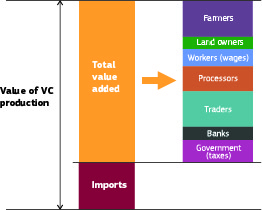1.2 What is the contribution of the value chain to economic growth?
The economic analysis aims at measuring and interpreting the profitability and sustainability of the value chain operations for all the actors directly involved. Its purpose is to inform on the economic effects of the value chain within the national economy in terms of growth generation and distribution of incomes. It also assesses its competitiveness and viability within the global economy. Standard tools of economic analysis are called for to estimate critical indicators. Actual precision depends on data availability, but only robust orders of magnitude are required. Main items expected are:
Profitability and sustainability for the VC actors: net operating profits, return on turnover, benchmarks for farmers’ net income, etc.
Total effects within the national economy: total value added (figure 1) and contribution to the GDP, to the public finances, to the balance of trade, etc.
Competitiveness and viability within the international economy: Nominal Protection Coefficient, Domestic Resource Cost Ratio.
Figure 1: Total value added and its components

The economic calculations can be done using spreadsheets or an existing software such as AgriFood Chain Analysis (AFA, developed by Cirad) (figure 2).
Figure 2: AFA software

The economic analysis also gathers evidence on how sub-chains perform differently. Indicators of profitability, direct value added generation, income distribution or employment can be broken down according to farm types, or related to one unit of product (kg, ton, functional unit…) or area (ha…) thus informing on varied aspects of the sub-chains performance.
Core questions:
CQ1.1. How profitable and sustainable are the VC activities for the actors involved?
CQ1.2. What is the contribution of the VC to the GDP?
CQ1.3. What is the contribution of the VC to the agriculture sector GDP?
CQ1.4. What is the contribution of the VC to the public finances?
CQ1.5. What is the contribution of the VC to the balance of trade?
CQ1.6. Is the VC viable in the international economy?
